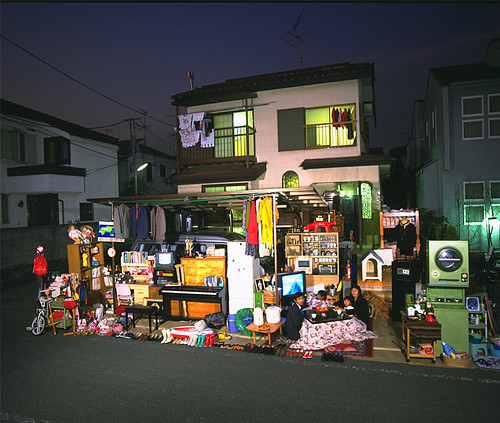The following photos give a sense of the incredible range of ownership of material stuff in today's world.
Stuff in Japan...

Stuff in Mali...

Stuff in China...

Stuff in India...

Stuff in the US...

All of the above photos are by Peter Menzel. There's more about these photos and his marvelous photography here and here.
The above photos are not intended as wholly representative of the countries and their economies but they help illustrate both the legitimate desire of many folks to gain access to material comforts and they also raise the question of "how much is enough?"
About a month ago Andrew Revkin explored the issue of The Endless Pursuit of Unnecessary Things. The full post (and links) is fascinating...
February 6, 2008, 10:32 am
‘The Endless Pursuit of Unnecessary Things’
By Andrew C. Revkin
Amid the flow of Super Tuesdays, Superbowl surprises, news about faltering energy projects and rising solar cities, I’ve been collecting threads that relate to a central theme of Dot Earth: the implications of humanity’s growing numbers and resource thirst.
Here are a few from the last few days:
- A radio commentary quoting one of the less-familiar dictums of Adam Smith, who is best known for championing economic growth, but in this case was warning about too much of a good thing.
- The hypnotically unnerving documentary “Manufactured Landscapes,” which glaringly displays the increasingly human-shaped face of Earth.
- A sociology paper proposing that the best way to lessen consumption for its own sake is to reduce how much people work. (Is there a win-win here, or am I missing something?)
- A paper in the journal Science on sustainability showing that, by one measure, afflictions related to affluence take away as many years of life as do ills associated with poverty.
These papers and observations all circle around the two questions at the heart of the sustainability puzzle that will largely determine the quality of human lives and the environment in which they are lived: How many? How much?
How many people will inhabit Earth in the next few generations?
How much stuff – energy, land, water, marine life – will they consume?
A few examples: The overlay of rising demand and lagging supply of oil or comparable liquid fuel will shape everything from economics to international conflict. The amount of coal extracted and burned (along with the oil) will influence climate for centuries to come. The extent of land used to grow fuel, food, or fiber will determine the costs of those necessities and also the fate of the world’s last untrammeled ecosystems.
Back to the related nuggets above.
I was listening to the public-radio program Marketplace and heard a guest commentary by Charles Handy, an expert on business management who founded the London Business School and is in residence at the Drucker School of Business of Claremont (Calif.) Graduate University.
He was musing on the ideas of two departed pillars of economics, Adam Smith and Peter Drucker, in relation to limits to growth.
An excerpt:
…I wonder how [Peter Drucker] would have reacted to some of the things that bother me. For instance, how would he respond to what I call “Adam Smith’s Great Conundrum?”
Adam Smith, the father of economics, 250 years ago, said: “An investment is by all right-minded people to be commended, because it brings comforts and necessities to the citizenry. But, if continued indefinitely, it will lead to the endless pursuit of unnecessary things.”
Now that I am living for a while in California, I am staggered by the amount of “unnecessary things” that I see in the malls that dot the suburbs. America is no different from anywhere else, of course — just more so.
The conundrum is this: All that stuff creates jobs — making it, promoting it, selling it. It’s literally the stuff of growth. What I’d love to ask Peter Drucker is: How do you grow an economy without the jobs and taxes that these unnecessary things produce?
Drucker saw business as the agent of progress. Its main responsibility, he said, was to come up with new ideas and take them to market. But not just any new ideas, please — only those that bring genuine benefits to the customers, and do not muck up the environment.
The market, unfortunately, does not differentiate between good and bad. If the people want junk, the market will provide. So we have to fall back on the conscience of our business leaders.
Then there was “Manufactured Landscapes,” a film examining how human demands for resources and products are transforming the physical world, and the environment experienced on a daily basis by humans caught up in the rush of urbanized, mechanized, work-centered life. It does so over the shoulder of the Canadian photographer Edward Burtynsky, who has made chronicling the face of the Anthropocene epoch his life’s work of late.
I saw a snippet of it when writing a post on the “urban age” last week, but finally had a chance to watch the DVD. It is an unforgettable experience, something like a mash-up of “Apocalypse Now” and “Modern Times.”
It is a sobering view, particularly the scenes in sprawling Chinese factory cities churning out the (unnecessary?) things that prosperous people seem to need in ever-rising amounts. Watch the hands of a young woman as she speeds through the 20 or so manipulations necessary to make an electronic device whose purpose she only can guess at. She makes 400 a day. Then watch as the camera pans cavernous halls full of similar workers, then cuts outdoors to the cordons of thousands of workers heading to yellow dormitories.
How many factories? How much stuff?
Then came “Sustainable Consumption and Worktime Reduction,” a paper by Juliet Schor, a sociologist at Boston College, that I stumbled on while surfing a 2005 special issue of the journal Industrial Ecology on the global impacts of cities. The entire issue is enlightening.
She chronicles how industrialized economies have generally translated productivity gains in the workplace into making more stuff (and money to buy stuff) instead of making less work (reducing work hours).
A world heading toward 9 billion, however, following that path of ever more work and money to buy ever more stuff, cannot be sustained, Professor Schor concludes:
Achieving a sustainable and equitable global solution is clearly incompatible with a worldwide replication of U.S. lifestyles or even the somewhat less damaging ecological impacts of the lifestyles of other industrialized countries. In such a situation, inhabitants of the global North can and should opt for a new economic and social vision based on quality of life, rather than quantity of stuff, with reduced work time and ecological sustainability at its core. Such a vision has the potential to create broad-based pressure for an alternative to the current system of ecologically destructive, inequitable consumer-driven growth. Indeed, the future of the planet increasingly depends on it.
This paper echoed ideas I explored in 2005, when writing on Bhutan’s experiment with “gross national happiness” as a substitute for the more familiar gross national product.
Finally, there was “Science and Technology for Sustainable Well-Being,” a paper in Science by John P. Holdren, the Harvard expert on energy, environment, development and lots of other things.
The paper is a sprawling portrait of a world poised between a livable path toward 9 billion and one wracked by disruption and suffering, along with a menu for limiting losses as we head into crunch time these next few decades. But one chart really grabbed my attention. By Dr. Holdren’s analysis, when you measure human tolls in years of life lost (e.g., a child cut down by disease loses decades; a grandmother dying of a stroke at 80 loses a few years.), the major afflictions of poverty and affluence do us in at roughly equal rates.
Childhood and maternal malnutrition, he estimates, erased 200 million life years in the year 2000. High blood pressure, cholesterol, obesity, and lack of physical activity erased 150 million life years. (There’s a long list of other causes, from war to tobacco.)
So at each end of the development ladder – from not enough to too much – we get into trouble.
So are we now locked into the “endless pursuit of unnecessary things?” In thinking about this warning from Adam Smith, I can’t help but feel bad for Thomas Malthus, who has taken all the heat from free-market champions of eternal growth over the years.
Maybe it was Adam Smith who was the first Malthusian prophet of doom.





No comments:
Post a Comment